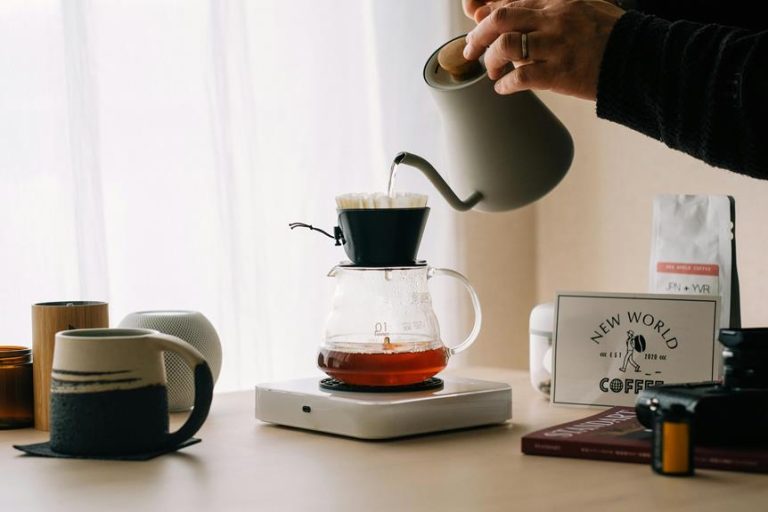How to Make Coffee in a Cuisinart Step-By-Step Guide

We’re excited to help you master the art of brewing coffee in your Cuisinart machine. With a few simple steps, you’ll be on your way to a perfectly balanced cup.
But before we get started, let’s make certain we’re on the same page. If you’re like us, you’ve probably experienced the frustration of a subpar cup of coffee.
To guarantee that doesn’t happen, we’ll walk you through the essentials, from measuring coffee grounds to selecting the right brewing options. But first, let’s start with the basics – gathering your coffee essentials. What do you need to get started?
Gather Your Coffee Essentials
To gather our coffee essentials, we first need a Cuisinart coffee maker, as it’s the central component in the brewing process.
Next, we’ll choose a coffee bean type, considering factors like roast level, acidity, and flavor profile.
We’ll also select a brewing technique, such as drip brewing or single-serve.
Measure Coffee Grounds Correctly
When measuring coffee grounds for our Cuisinart brew, we need to take into account a few critical factors to guarantee the best flavor.
First, we’ll focus on achieving the ideal coffee grounds ratio, which typically ranges from 1:15 to 1:17 coffee to water.
To achieve this ratio, we’ll also need to choose the right grind and accurately measure our coffee scoops.
Coffee Grounds Ratio
Achieving a perfect balance is essential in crafting the ultimate cup of coffee. We find that the ideal coffee grounds ratio is vital in bringing out the best coffee flavor. A general rule of thumb is to use 1 tablespoon of coffee for every 6 ounces of water.
Consider the following when adjusting your ratio:
- Stronger brewing techniques require less coffee
- Weaker brewing techniques require more coffee
- Personal taste plays a significant role in coffee flavor
- Experiment with ratios for best results
- Record your ratios for future brewing sessions
Choosing the Right Grind
Harmony between grind size and brewing method is essential for perfect extraction.
We consider factors like bean origin, flavor profile, and roast levels to determine the best grind size.
Different grind sizes suit various brew methods, while grinder types and freshness factors also influence our choice.
Balancing these elements guarantees the perfect extraction time and a rich, full-bodied coffee.
Measuring Coffee Scoops
Measuring coffee scoops correctly is essential in revealing the full flavor potential of our brew, as it directly affects the extraction process and overall taste experience.
We’ll discuss various coffee scoop types and measuring techniques to guarantee the perfect balance.
- Use a digital scale for precise measurements (1-2% accuracy).
- Choose between level or rounded scoop techniques.
- Experiment with 1:15 to 1:17 coffee-to-water ratios.
- Store coffee beans in a cool, dry place to preserve flavor.
- Consider the Cuisinart’s built-in scoop or a separate coffee scoop.
Prepare the Cuisinart Machine
To prepare the Cuisinart machine, we start by verifying it’s properly assembled and installed on a stable, flat surface. Regular machine maintenance is key to peak performance. For troubleshooting tips, refer to the table below.
| Issue | Solution |
|---|---|
| Leaks from coffee maker | Check for loose connections and tighten if necessary |
| Coffee maker not turning on | Verify power cord is securely plugged in and outlet is working |
| Coffee not brewing correctly | Check for clogged filters and clean if necessary |
Add Water to the Reservoir
When adding water to the Cuisinart reservoir, we must consider the reservoir capacity limits to avoid overfilling.
The water level guidelines, which are typically indicated by a max line on the side of the reservoir, serve as a reference point to guarantee we’re using the correct amount.
We’ll examine these limits and guidelines to ascertain accurate water measurement for peak coffee brewing performance.
Reservoir Capacity Limits
Before we start brewing, we need to confirm the reservoir is filled to the right level.
- Reservoir capacity limits vary by model, so check your user manual for specifics.
- Overfilling can lead to spills and messes during brewing.
- Underfilling may result in weak or under-extracted coffee.
- Regular reservoir maintenance is essential for peak performance.
- Be mindful of capacity considerations to guarantee the best possible brew.
Water Level Guidelines
Precision is key when adding water to the reservoir, as even minor deviations from the recommended levels can greatly impact the flavor and quality of our coffee.
We’ll aim for the ideal water level, considering factors like water temperature and brew time. Fill the reservoir to the recommended max line for strong brews or adjust to the min line for lighter roasts.
Choose Your Brewing Options
The Cuisinart coffee maker offers various brewing options, allowing us to customize our coffee to suit our tastes.
With different brewing methods, we can experiment with distinct flavor profiles and find our perfect cup.
We consider the following options:
- Strong brew for a bold flavor
- Regular brew for a balanced taste
- Extra-bold brew for a rich flavor
- Iced coffee for a revitalizing drink
- Single-serve option for a convenient cup
Place the Coffee Filter
We’re moving on to the crucial step of placing the coffee filter.
Confirm you’re using the correct filter type for your Cuisinart model. Paper or gold-tone filters are common types, so refer to your user manual for guidance.
Position the filter in the filter basket, aligning it with the basket’s edges for proper filter placement.
Start the Brewing Process
Now that the filter is in place, it’s time to start the brewing process.
To guarantee the best flavor, we set the brewing temperature to the ideal range of 195°F to 205°F. This temperature range helps extract the perfect balance of flavors and oils, preserving coffee freshness.
Key brewing process considerations include:
- Confirming the water reservoir is filled to the recommended level
- Selecting the desired coffee strength and flavor profile
- Allowing the machine to heat the water to the best brewing temperature
- Monitoring the coffee’s progress (we’ll cover this in the next step)
- Using fresh, high-quality coffee beans for the best flavor
Monitor the Coffee Progress
As the brewing process begins, monitor the coffee’s progress by keeping an eye on the Cuisinart’s control panel and the coffee’s flow.
Check the brew time to verify it aligns with your desired strength.
Observe the aroma release, as it indicates the coffee’s flavor and oil extraction.
This helps us gauge the ideal brewing point and adjust future brews accordingly.
Serve and Enjoy Your Coffee
Once the brewing cycle is complete and the Cuisinart’s control panel indicates the brew is done, carefully lift the carafe from the warming plate and pour the freshly brewed coffee into your cup.
Now it’s time to perfect your coffee serving techniques.
- Use the right water temperature to prevent burnt flavors.
- Experiment with coffee-to-water ratios for ideal taste.
- Add a sweetener or creamer for a perfect pairing.
- Consider the type of coffee beans used for flavor profiles.
- Pay attention to the coffee’s acidity level when selecting a pairing.
Final Thoughts
We’ve successfully navigated the process of brewing coffee in a Cuisinart machine.
By following these straightforward steps, you’ve guaranteed a properly assembled and clean machine, measured coffee grounds accurately, prepared the machine, and selected your desired brew strength.
With the brewing process complete, we’re now ready to pour and serve our freshly brewed coffee. Monitor the machine’s progress, and you’ll be enjoying a perfect cup in no time.






